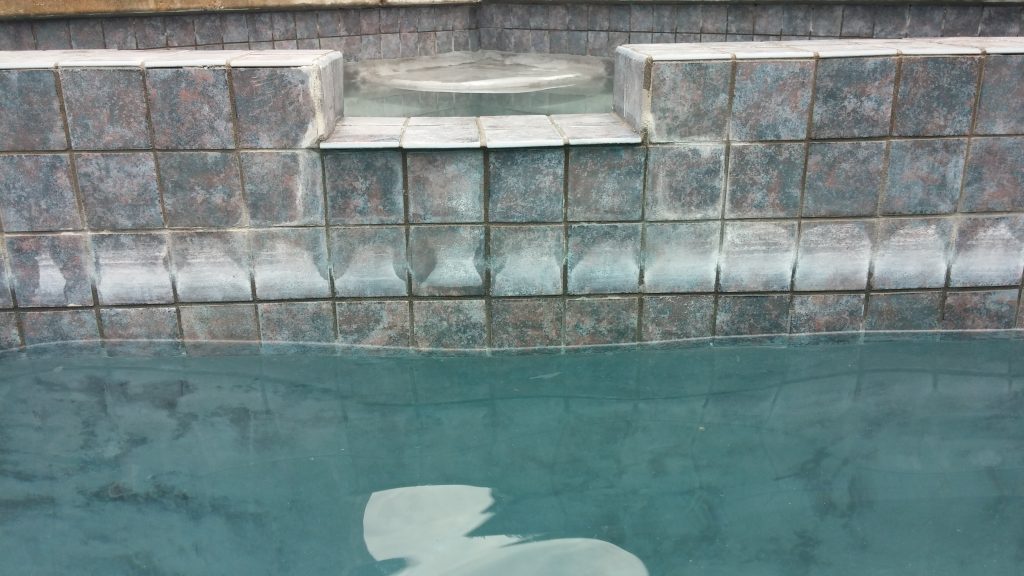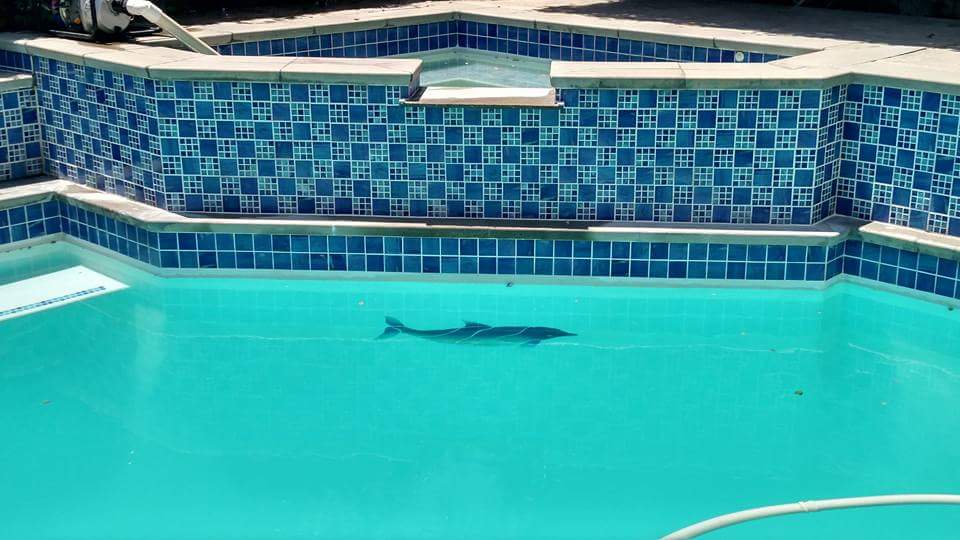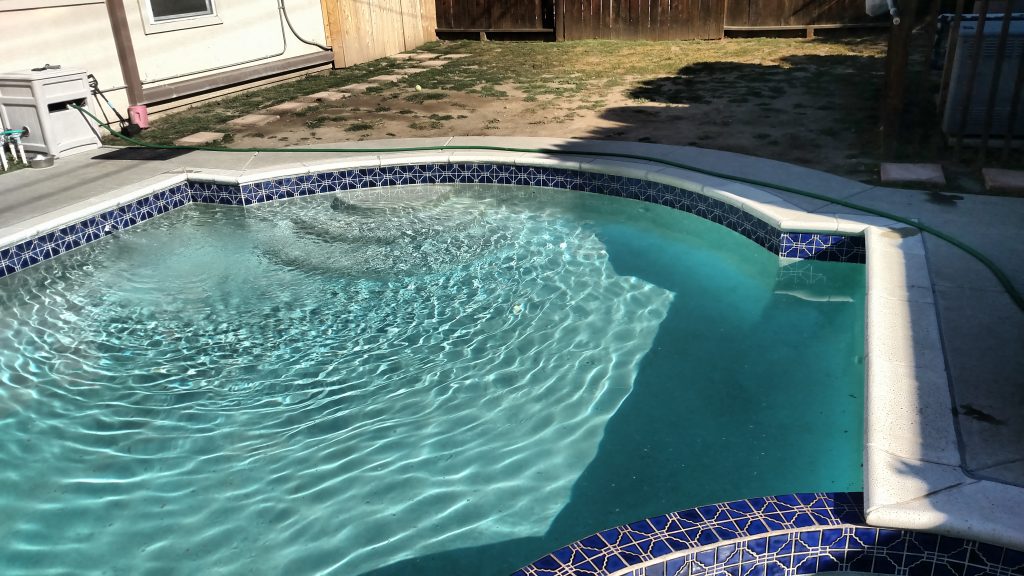Most likely, if you see spots along the waterline, you are dealing with a calcium deposit. And you’ll want to know how to remove lime from the pool, unfortunately, calcium deposits tend to be incredibly difficult to clean.
There are some reasons why you may start to notice these spots around the waterline.
The first reason is hard water, which can leave a calcium residue over time. If you live in an area of the country with hard water, it is likely that you have already noticed this accumulation in your faucets, sinks and even bathtubs.
The second reason is the heat. The high summer temperatures cause the water in the pool to evaporate more, and also raise the water temperature.
When combined with the third reason, the chemical composition of your pool, these conditions can cause calcium deposits.
Specifically, if your pool has a high pH, high alkalinity and hotter water, the calcium scale will begin to form.

The reason why this situation occurs so often in the water line is due to evaporation. These calcium crystals can appear as nodules that dot the metal and plaster, or they can become scabby deposits that live in the corners of the pool.
Technically, these are two different things. Calcium carbonate, which tends to manifest as a scaly substance on the surface of the pool, and calcium silicate, which is grayish-white and harder. Either way, they are not exactly aesthetically pleasing.
What does lime do to your pool?
Obstructed filters
Pool filters are designed to treat water or other types of waste typical of the pool: insects, leaves, etc. But they are not designed for hard calcium deposits.
As more and more hardened calcium passes through the filter, the system will slow down and not work as well due to clogging.
Damage to the Plaster
If left untreated, calcium deposits will continue to grow and spread to other areas of the pool, including, in the background. This can result in the creation of clumps in the plaster that you will have to eliminate if you do not want the finish to be damaged.
Irritation of eyes and skin
If people swim in a pool with excess calcium, which is causing deposits, there is a great chance that there will be skin and eye irritation.
Calcium deposits and scaling are unattractive, make swimming pools uncomfortable for swimming and can cause serious and costly long-term damage.
Steps to Remove Lime
Limescale deposits can form along the waterline of your pool. This is usually caused by a high pH, high alkalinity or a high concentration of calcium. Constant temperature changes along with rapid evaporation will cause the deposits to settle along the side of the pool wall. If the deposits are not removed soon, it can cause permanent damage to the surface of the pool.
Cleaning with vinegar
Baking soda, borax, dish soap, toothpaste, and vinegar can be used in much the same way to clean calcium deposits, so you can use most of the information related to the vinegar and apply it also to cleaning agents.
What you need for cleaning with vinegar:
- A cleaning brush. With soft bristles, not metallic.
- A bottle of spray.
- Vinegar, a 5% solution.
Once you have these items, you can start cleaning.
- The first step is to stop all use of the pool until a water test can be performed. If the test reveals that the levels are within range, you can use a stain remover to remove deposits from the waterline. If the pH, alkalinity or calcium levels are too high, they should be reduced before using a scale and scale cleaner.
- It is recommended to start first by lowering the hardness of the water. The hardness can only be lowered by partially draining and then filling the pool. Your pool needs a hardness level of 200 ppm to 400 ppm. A level of hardness above 400 ppm can lead to scale formation on the surface of the pool and equipment and can also cause cloudy water.
- Once the pool has drained, and filled again, check that the hardness is within range. If it is not, you must repeat step 2 until you normalize the hardness. Only in that case can you adjust the alkalinity. You should retest before doing so because the alkalinity should be lower than before. To reduce alkalinity, you can use dry acid or muriatic acid. The necessary amount of any of the chemical products will vary according to the size and volume of the pool and the reading of alkalinity.
- Once the alkalinity is within the range, the pH can be adjusted. For this, a negative pH is used, in case of a high pH. Once the pH is balanced, we can move on to the final step.
- The final step will be to use the vinegar. Before adding the product, (following the package instructions), make sure you have a pool brush handy to brush the walls as needed. There are no special tricks. You can put the vinegar in the bottle and spray the solution on the calcium deposits or simply pour it from your own bottle, then use the brush to scrub.
These types of cleaners tend to work quite well if you detect and solve the problem from the beginning, and of course, you should use them fairly regularly to avoid accumulation.
If you do all these steps, and still have lime deposits that are difficult to remove, try the following.

Cleaning with muriatic acid
With the vinegar and the other mild cleansers that we have already mentioned, you can enter the pool while you are cleaning. With muriatic acid, however, this is not recommended.
Muriatic acid is more powerful and more dangerous when handling. You can find this chemical in a home improvement store or pool supply store.
What you need for cleaning with muriatic acid:
- Muriatic acid container.
- Safety glasses.
- Rubber gloves.
- Respirator.
- Plastic cube.
- Measuring cup of plastic.
- Plastic spoon
- Plastic spray bottle.
- Marker.
- Non-abrasive scourer
This list of materials is enough for you to realize that this goes beyond the maintenance of the pool for beginners. We want to remind you that muriatic acid is dangerous.
- Put on goggles, gloves and the respirator. Then head outside with all your ingredients to start mixing. Absolutely do not attempt to mix in a closed area.
- Fill your bucket with four liters of water. Pour 230 grams of muriatic acid with the measuring cup slowly into the water. Always pour the acid in the water instead of the other way round, as the acid is more likely to splash. Another thing to keep in mind is that you should pour slowly since this mixture produces heat.
- With the plastic spoon mix the water and the acid. Again, do it slowly, because you do not want it to boil.
- Carefully fill the plastic bottle with a mixture of water and acid.
- Use the marker to label the measuring cup, spoon and spray bottle with “Muriatic acid”. Do not try to use the chemical for anything else. If you are worried that this may happen, leave the bottle aside for proper disposal.
- You should always stay out of the pool, use the spray bottle to spray the waterline of the pool and rub with the non-abrasive scouring pad.
Get in touch with your local pool supply company or with the municipality to learn how to get rid of any unused muriatic acid. Do not simply discard it or pour it down the drain.
Because muriatic acid is much stronger than vinegar or other cleaning products mentioned above, you can eliminate calcium deposits that are much more advanced. That said, with deposits that have been growing and hardening for a long time, sometimes even muriatic acid is not enough.
If that is your situation, you have a remaining option. Pressure washing.
Cleaning with a pressure washer
Cleaning with a pressure washer is something that professional pool cleaners use, called “blasting accounts”. This process uses compressors to “blow up” pearls, sand and other materials (depending on the specific tool used) on your tile at a high speed to basically blow or scrape the calcium deposits.

It works surprisingly well, and it’s fast. And best of all, you are not doing the work yourself. Unfortunately, it can also be expensive, especially if you need to call them to do it regularly.



